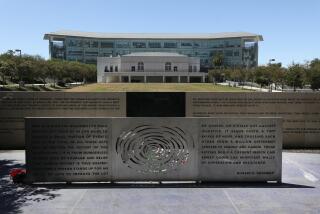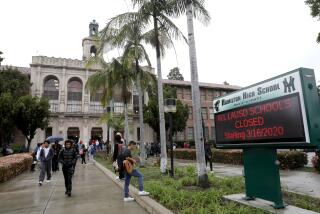Various Factors Led to School Budget Crisis
- Share via
A combination of factors has contributed directly to the budget crisis faced by school districts across the state, including those in the Southeast and Long Beach areas.
* Inadequate cost-of-living adjustments: Last year, schools received an inflation adjustment of 3% rather than the 4.76% that would have kept them about even with inflation. In the Compton Unified School District alone, that difference amounted to $1.8 million, district officials said. This year, the cost-of-living adjustment likely will be between 0 and 1.5%, even though inflation has continued to drive up costs at about the same rate as before.
* Waste and inefficiency: In a recent interview, State Controller Gray Davis said that, conservatively speaking, school districts probably waste two to three cents of every dollar. Although he couldn’t document his estimate, some local educators say much the same thing, complaining that school systems are grounded in the same bureaucracy and mismanagement that sometimes paralyze other governmental bodies.
* Rising school district spending: The reasons vary, but the bottom line is that many districts’ expenses are rising faster than inflation. Factors that contribute to rising costs include diminished or inadequate state funding for textbooks, busing, driver education and special academic programs. The expense of preventing or repairing vandalism has also increased.
Some districts, including Los Angeles Unified and Montebello Unified, have previously given employees salary raises at rates well above state-funded inflation adjustments. Defenders of the policy point out that teachers still make less than other professionals.
Districts may also be stuck this year with a new tax obligation, a property tax collection fee. The annual fee for Montebello schools would be about $260,000, for the Whittier Union High School District about $150,000, for Long Beach Unified about $800,000. Legislation currently under consideration would eliminate the tax.
* Taxation limitations: In 1978, Proposition 13 slashed property taxes, the traditional source of money for schools. Moreover, Proposition 13 and other laws have limited the ability of schools to raise money through new property taxes.
Voter-approved bonds require a two-thirds majority, and voters have proved to be apathetic or unsympathetic. In March, the Whittier Union district failed to pass a $75-million bond issue by 37 votes. Only one in 10 voters bothered to cast a ballot.
Unable to pass tax measures, some districts have turned to other kinds of bonds. Certificates of participation do not require voters’ consent, but the certificates create a long-term financial burden because they are typically paid back out of a district’s general fund.
* Declining lottery revenues: Lottery proceeds have fallen 19% since they reached their peak two years ago. The schools, which receive a 34% share of the take, have seen their portion shrink. In Long Beach, lottery funds were more than $2 million lower than the district expected last year. Lottery funds were originally supposed to pay for extras, but numerous school districts have come to rely on the money, which typically constitutes about 3% of a district’s general fund.
“How can we continue to treat that money as if it were for special goodies when in fact the base educational program is receiving minimal dollars,” Whittier Union Supt. Lee Eastwood said. “We’re using the lottery money for counseling and staff development programs, and to augment programs to prevent dropouts. Are those programs extras or not?”
More to Read
Sign up for Essential California
The most important California stories and recommendations in your inbox every morning.
You may occasionally receive promotional content from the Los Angeles Times.











